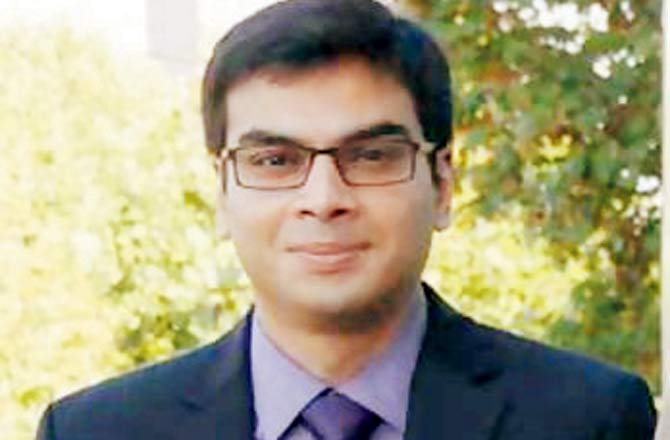A German-based systems biologist from Mumbai analyses COVID-19 data across six countries to say each and every Indian stands the risk of being infected. Yet, there is good news

Young men in Dharavi busy on their mobile phones. Pic/Atul Kamble
Dr Nachiket Vartak is no stranger to the world of pandemics and diseases. As a systems biologist, who runs a research group at the Leibniz Research Centre in Dortmund, Germany, the alumnus of St Xavier's College and IIT Bombay, has been using imaging, molecular and cell biology to study liver physiology and diseases.
ADVERTISEMENT
Tracking the Coronavirus pandemic closely since its outbreak earlier this year, Dr Vartak, on March 28, came up with concern-worthy findings, based on dataset that he pulled out from Johns Hopkins University, for six countries—Germany, Spain, Italy, US, India and South Korea—to understand the trajectory of the spread of the virus.
His model, which he prefers to call an "exercise for curiosity", was prepared based on data until March 27. His prediction is that by August, there will be at least 6,25,000 infections in India. "But the uncertainty means that it could go up to 1.3 billion—in the extremely unlikely worst case," he shared on the blog, emergentnoise.com.

Dr Nachiket Vartak
As of April 1, his prediction was that India would have 1,522 infected individuals. Incidentally, the report that morning showed India stood at 1,509 patients. We reached out to Dr Vartak, to help understand where India stands in the fight against COVID-19.
Edited excerpts from the interview.
You chose to look at six specific countries to analyse your data. Why?
I chose the countries that are most relevant to me. First, India and Germany. India is my native country and I am an Indian national. Germany is where I work and have stayed for the last decade. The US was chosen because like India, it is a large country. Spain and Italy represented countries that did not handle the pandemic well in the early stages. South Korea, on the other hand, is a country that has actually managed to flatten the curve already. Incidentally, all these countries have instituted social distancing regulations in a democratic setup. This is why China was excluded—their outbreak was largely localised to Hubei province and the government is not hindered by the democratic process, when it comes to making policy decisions.
For your predictions, you've used an equation called the Hill Function to explain and analyse the rise in the number of corona cases, till until August. Could you explain, how it can help present a very accurate number.
The Hill Function is well known to biologists because it represents a 'self-enhancing steady-state process'. There are many self-enhancing processes—here's an example that Mumbaikars will intuitively appreciate—cars on the road. Cars can be on the road, or they can be parked, and all through the day cars are continuously coming onto and off the road. But every Mumbaikar knows that the more cars there are on the road, the slower they can move, and the longer the car remains on the road. At a particularly busy traffic junction, having even one oddly positioned extra car, can block the entire flow and cause a traffic jam. And the more cars there are, the more chances that this will happen. If we study how many cars come on the road every hour, and how many leave, we can capture this into a calculation and make a prediction about how many cars will end up on the road at some time in the future, and whether a traffic jam will occur or not. The spread of a disease is also like that—some people get infected and people also recover. But the more people there are infected, the higher the chances that tomorrow even more people will be infected. The process of infection enhances itself. So, using the Hill Function, we can calculate how many people will be infected on a given day. The goal is to find out if we will ever exceed the capacity of the road and cause a traffic jam, which is if we will exceed the capacity of our hospitals and doctors and cause a health crisis. The Hill Function is a mathematical representation of this kind of pattern and as in all these cases, the more data there is to show how the curve has changed over the last days, the more accurately it can estimate what will happen in the future. If you want to prevent the traffic jam (health crisis), there are two things we can do—get the cars off the road fast (develop a cure for the disease and make people recover faster), or restrict the number of cars that can get on the road (social distancing and lockdown). Developing the medicines and vaccines is an effort that is already underway, but this will take at least a few months to design, develop and mass produce. Eventually, it will happen. Social distancing, we can all do immediately, and that's what we are doing.
What, according to you, is most striking about your findings?
The most striking thing is how much of a delay there is with the rise of infections for India. While most countries I included are already in the 'rapid-rise' part of the epidemic. India will reach this part only in mid-May. The other good news is that the lockdown seems to be working. The way the virus is spreading right now is similar to the way it has spread in other countries, which means that like other countries, we will be able to control this disease, if we take the appropriate measures.
India is the only country that is at the beginning of the curve, and has not experienced exponential growth. Yet, you've predicted these numbers could go up to 6,25,000 by August. Why so? Also, are you considering the lockdown factor, in your findings.
India has also imposed strict measures from the start, and we are even doing slightly better than Spain and Italy in controlling how the infection spreads. The data includes some of the period since lockdown started. The reason why India has a higher number than other countries is because we have a higher population, and population density than other countries. So, we expect that more people will be infected.
You've said that the "uncertainty" around this means that the cases could go up to 1.3 billion. This means the entire population.
The uncertainty tells us how well the data can be used to estimate the future. This indicates that at the moment, we are not in a position to relax and say "everything is fine, we are in control". If we do the things we are doing right now—lockdown, curfew, then we will have infections in less than 0.005% of the population. But if we drop the ball, then the situation can spiral out of control. While indications are positive, we still have to be vigilant—the storm has just begun.
In a report in the Science, Dr Ramanan Laxminarayan, founder and director of the Center for Disease Dynamics, said that "India is probably the first large developing country and democracy into which this pandemic will arrive." And unlike, China or any of the other countries, included in your data, we are still not well equipped to handle this fight. How best, on the basis of your own findings, do you think India can flatten the curve?
I completely agree with Dr Laxminarayan. The Indian system does not have the clout of the Chinese in controlling the population, and neither is the medical setup in India sufficient for our large population. Dr Laxminarayan says, "There will have to be a uniquely Indian response to COVID-19." I think in India, what people do by themselves—whether they understand the risks, seriousness and follow the guidelines—is much more important than it was for any other country. This is what will be unique about the Indian response. I am optimistic that we will manage to slow it down and flatten the curve eventually, but it has to be a committed response. Even a few people who don't follow the current restrictions can keep the disease alive and demolish the efforts of those who are doing their best. I read in the news that there was a congregation of 9,000 people, out of which 400 ended up being infected. This is criminal and dangerous to all of us. It is blatant disregard of public effort and the people who make such assemblies are threatening the lives of every single one of us.
Why is understanding and analysing data, so important to understanding the way this pandemic is spreading?
Pandemics tend to be similar in some respects, but different in their details. This particular one is a disease that is slow to start, and mild for most people. Most people do not feel very sick even if they have it, so it is very likely to be ignored. It flies "under the radar", so to speak—by the time you see them cough, the person may have spread the disease already for the last 14 days! And yet, for about 10 per cent of the infected people, especially the elderly and children, it does become life-threatening. In a large and densely populated country, even 10 per cent is a number larger than entire populations of other countries. The denser the population, the faster a disease spreads from person to person. In a country like ours, if we are half-hearted in our reaction, the spread will get out of hand. This is why we need to keep a very detailed track of what is happening with the disease. It tells us how effective we are at stemming the spread, how much time we have to prepare our medical facilities. And that's the important point. People will get infected, but as long as our medical facilities can cope with the number of infected individuals on any given day, we will eventually win. That's what makes this a numbers game—number of infections, number of tests we do, number of hospital beds, number of doctors.
6,25,000
Number of Indians Dr Vartak estimates will be infected by August
Catch up on all the latest Mumbai news, crime news, current affairs, and also a complete guide on Mumbai from food to things to do and events across the city here. Also download the new mid-day Android and iOS apps to get latest updates
 Subscribe today by clicking the link and stay updated with the latest news!" Click here!
Subscribe today by clicking the link and stay updated with the latest news!" Click here!






